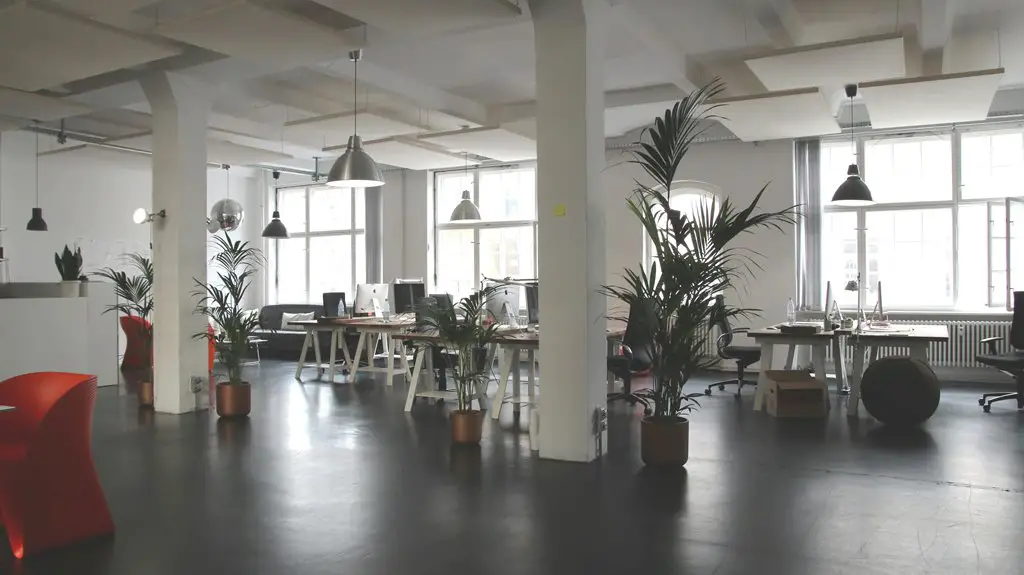To integrate plants into your minimalist office design, start by choosing low-maintenance varieties like snake plants or pothos. Place taller plants in corners to draw the eye upward, while smaller varieties can brighten desks. Use geometric pots in neutral tones to maintain a clean look. Group plants in odd numbers, and consider creative placements like hanging planters or wall-mounted shelves. These choices will enhance your workspace’s aesthetic appeal and air quality, and there’s more to explore on effective design strategies.
Table of Contents
Key Takeaways
- Choose low-maintenance plants like snake plants or pothos that thrive in indoor lighting conditions for easy care.
- Use a single statement plant, such as a fiddle leaf fig, as a focal point to enhance visual interest.
- Incorporate plants in varying heights and group them in odd numbers for a natural, dynamic arrangement.
- Select pots that align with the office’s color palette, focusing on neutral tones or geometric designs to maintain minimalism.
- Position plants strategically near windows or in corners to maximize space and encourage growth while keeping surfaces clear.
Choosing the Right Plants for a Minimalist Office
When you decide to integrate plants into a minimalist office, choosing the right ones can enhance both aesthetics and productivity.
Focus on low-maintenance varieties that thrive in minimal light, like snake plants or pothos. Their sleek shapes complement clean lines, keeping your space uncluttered.
Consider using a single statement plant, such as a fiddle leaf fig, to create a focal point without overwhelming the design. Incorporate plants with varying heights to add depth while maintaining simplicity.
Avoid overly colorful or complex foliage, as they can clash with minimalist principles. Ultimately, choose pots that align with your office’s color palette—neutral tones or geometric designs work best.
This careful selection can transform your workspace into a serene and inviting environment.
The Benefits of Incorporating Plants in Your Workspace
Incorporating plants into your workspace offers a range of benefits that can transform your environment.
You’ll breathe cleaner air, stay focused on tasks, and enjoy a boost in aesthetic appeal.
Plus, a touch of greenery can make your minimalist office feel more inviting and inspiring.
Improved Air Quality
As you enhance your workspace with plants, you’ll likely notice a significant improvement in air quality.
These green additions not only beautify your environment but also purify the air you breathe.
Here are three key benefits of incorporating plants into your office:
- Reduction of Airborne Pollutants: Plants absorb toxins like formaldehyde and benzene, reducing harmful substances in the air.
- Increased Humidity: Through transpiration, plants release moisture, helping to maintain a comfortable humidity level that can prevent dry skin and respiratory issues.
- Enhanced Oxygen Levels: By photosynthesizing, plants produce oxygen, ensuring you have a fresher and more invigorating atmosphere to work in.
Integrating plants into your workspace improves air quality and creates a more inviting and healthy work environment.
Enhanced Focus Levels
While you mightn’t realize it, having plants in your workspace can considerably boost your focus and productivity. Studies show that the presence of greenery can increase concentration levels, helping you tackle tasks with greater efficiency.
When you surround yourself with plants, you create a calming atmosphere that reduces stress and promotes mental clarity. This natural element can help you feel more connected to your environment, allowing you to work more effectively.
Even just a small desk plant can make a significant difference in your ability to stay on task. By integrating plants into your minimalist office design, you’re not only enhancing the visual appeal but also fostering a workspace that encourages focused and productive work sessions.
Aesthetic Appeal Boost
Plants not only enhance your workspace’s atmosphere but also considerably elevate its aesthetic appeal.
Incorporating greenery into your minimalist office can transform the environment, making it feel more inviting and vibrant.
Here are three ways plants boost your office’s aesthetic:
- Color Variation: Lush green hues contrast beautifully with neutral tones, adding life to your space.
- Texture Contrast: The varied textures of leaves create visual interest, breaking the monotony of sleek surfaces.
- Natural Art: Arranging plants strategically can serve as a unique focal point, showcasing your personal style and creativity.
Strategic Plant Placement for Maximum Aesthetic Appeal
Incorporating greenery into your minimalist office design can transform the space, enhancing both aesthetic appeal and overall well-being.
To maximize impact, consider placing taller plants, like snake plants or fiddle leaf figs, in corners to draw the eye upward and create a sense of height. Use smaller plants, such as succulents or peace lilies, on desks or shelves to maintain a clean look while adding liveliness.
Incorporate taller plants in corners and smaller ones on surfaces for a vibrant, organized minimalist office.
Grouping plants in odd numbers often feels more natural and visually pleasing. Don’t forget about natural light—position plants near windows to encourage growth and brighten the atmosphere.
Finally, consider the color and texture of your plants to complement your office palette, ensuring they harmonize with your minimalist design.
Low-Maintenance Plant Options for Busy Professionals
If you’re a busy professional, you need plants that won’t demand too much of your time.
Luckily, there are plenty of low-maintenance options that can thrive in an office setting with minimal care.
Let’s explore some of the best plants and easy care tips to keep your workspace green and vibrant.
Best Low-Maintenance Plants
When you’re balancing a busy schedule, it’s easy to overlook the upkeep of office greenery.
Opting for low-maintenance plants can bring life to your workspace without demanding too much of your time.
Here are three great options that thrive with minimal attention:
- Snake Plant: This resilient plant tolerates low light and infrequent watering, making it perfect for busy professionals.
- Pothos: With its trailing vines, pothos is adaptable and thrives in various lighting conditions. It only needs watering when the soil is dry.
- ZZ Plant: Known for its glossy leaves, the ZZ plant can survive on neglect, requiring minimal light and water.
Integrating these plants into your minimalist office design adds a rejuvenating touch without overwhelming your schedule.
Care Tips for Office
While your busy schedule may leave little room for plant care, keeping your office greenery thriving is easier than you think.
Start by choosing low-maintenance plants, like snake plants or pothos, which require minimal attention. Water them sparingly—once every couple of weeks is usually sufficient. To avoid overwatering, always check the soil moisture first.
Place your plants in indirect light; they’ll thrive without direct sunlight. Dust their leaves occasionally to keep them clean and healthy.
Consider setting reminders on your phone for watering and fertilizing, ensuring you stay on track. Finally, rotate your plants occasionally for even growth.
With these simple tips, you’ll create a vibrant office environment without overwhelming your schedule.
Creative Ways to Display Plants in a Minimalist Design
Incorporating plants into a minimalist office design can enhance the space’s tranquility and aesthetic appeal.
To creatively display your greenery while maintaining a clean look, consider these ideas:
- Hanging Planters: Suspend plants from the ceiling using sleek, modern macramé or metallic holders. This saves space and adds visual interest.
- Wall-mounted Shelves: Install simple, floating shelves to showcase small pots. This elevates plants to eye level and keeps your desk clutter-free.
- Geometric Pots: Choose pots with clean lines and unique shapes. Opt for monochromatic colors or subtle textures that blend seamlessly with your decor.
These simple yet stylish displays not only bring life to your workspace but also reinforce the minimalist aesthetic you’re aiming for.
Combining Plants With Minimalist Decor Elements
To create a cohesive look in your minimalist office, combining plants with decor elements is key. Start by choosing planters that align with your decor style—think sleek ceramic pots or simple metal containers.
Position plants in areas where they complement your workspace, like beside a clean-lined desk or on a floating shelf. Use neutral colors to maintain a calm atmosphere while allowing greenery to pop. Incorporate natural materials, like wooden accents, to create warmth without clutter.
Frequently Asked Questions
Can I Use Artificial Plants in a Minimalist Office Design?
Absolutely, you can use artificial plants in your minimalist office design. They add a touch of greenery without the maintenance of real ones, keeping your space clean and stylish while still providing a calming atmosphere.
How Do I Choose the Right Pot for My Plants?
When it comes to choosing the right pot for your plants, you’ll want to strike while the iron’s hot. Consider size, material, and color to guarantee they complement your style while promoting healthy growth.
What Are the Best Colors for Plant Pots in a Minimalist Space?
For a minimalist space, choose plant pots in neutral colors like white, gray, or beige. These shades harmonize with your decor, allowing the greenery to stand out without overwhelming the simplicity of your design.
How Do Plants Improve Air Quality in an Office?
Plants improve air quality in your office by absorbing carbon dioxide and releasing oxygen. They also filter harmful toxins, increase humidity, and can enhance your mood, creating a healthier and more productive work environment for you.
Are There Any Plants That Are Toxic to Pets?
If you’re picturing a vibrant garden in your home, keep in mind that some plants, like lilies and philodendrons, can be toxic to pets. Always check before bringing new greenery into your space.




